23.07.2019
India launches robotic mission to land on the moon
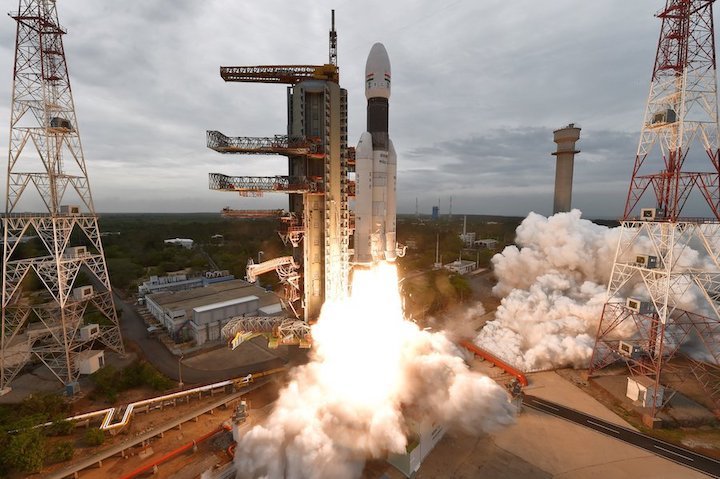
Seeking to become the fourth nation to successfully land on the moon, India launched an ambitious robotic lunar mission named Chandrayaan 2 on Monday, targeting a touchdown near the lunar south pole Sept. 6.
Consisting of an orbiter, lander and rover, the Chandrayaan 2 mission is India’s most daring space project to date. Chandrayaan 2 lifted off at 0913 GMT (5:13 a.m. EDT) Monday from the Satish Dhawan Space Center on India’s southeastern coast.
Heading into a cloudy sky and arcing toward east from the launch base over the Bay of Bengal, Chandrayaan 2 rode into space on top of a GSLV Mk.3 rocket, the most powerful launcher in India’s inventory.
The GSLV Mk.3 fired off the pad with 2.2 million pounds of thrust from two side-mounted solid rocket boosters, then ignited a twin-engine liquid-fueled core stage around two minutes after liftoff. After jettisoning the solid-fueled rocket boosters and its nose cone, the GSLV Mk.3’s core stage shut down around five minutes into the mission, followed by ignition of an advanced cryogenic upper stage engine burning super-cold liquid hydrogen and liquid oxygen.
The upper stage fired for about 11 minutes and burned to depletion to propel the Chandrayaan 2 spacecraft into the highest orbit possible. U.S. military tracking data indicated the rocket placed Chandrayaan 2 in an orbit stretching more than 28,000 miles (45,000 kilometers) above Earth, some 3,700 miles (6,000 kilometers) higher than expected.
That is good news for Chandrayaan 2, which will need less fuel to send itself toward the moon through a series of orbit-raising maneuvers planned over the next few weeks, the Indian Space Research Organization said.
Moments after shutdown of the upper stage engine, ISRO’s team at the launch control center confirmed separation of the Chandrayaan 2 spacecraft. A camera aboard the rocket showed the spacecraft flying away from the upper stage, prompting a round of applause in the control center.
“Today is a historical day for space and science and technology in India,” said K. Sivan, ISRO’s chairman, after officials declared the launch a success.
The combined Chandrayaan 2 spacecraft weighed about 8,547 pounds (3,877 kilograms) fully fueled for launch, and the probe measures 19 feet (5.8 meters) long and more than 10 feet (3.1 meters) in diameter.
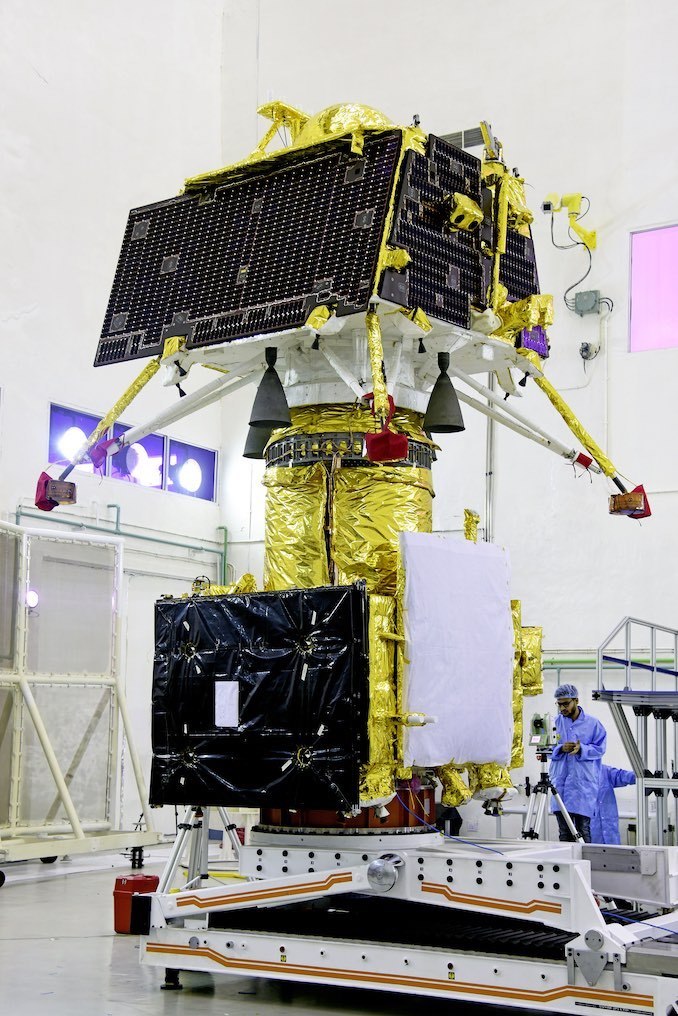
Sivan said the higher-than-expected orbit achieved by the GSLV Mk.3 launcher will result in “more life and more fuel for flying maneuvers” on Chandrayaan 2’s journey to the moon.
The launch was delayed from last Sunday after the launch team detected a leak on the GSLV Mk.3’s cryogenic upper stage. Workers reportedly tightened a component or connector on the rocket to resolve the problem, and ISRO resumed launch preparations for a second attempt Monday.
“It is the beginning of an historical journey of India to Earth’s moon, and to land at a place near the south pole to carry out scientific experiments to explore another world,” Sivan said. “In fact, after the serious technical snag we had (July 14) — and we fixed that technical snag — now ISRO has bounced back with flying colors.”
Sivan praised the workforce at the launch base for quickly resolving the problem on the rocket’s upper stage.
“(Over) the next 24 hours, the work done in the center was mind-boggling, and quickly the vehicle was brought back to normal and (we) identified the root cause of the technical snag correctly,” Sivan said.
Indian officials adjusted Chandrayaan 2’s flight plan to accommodate the launch delay, while still keeping to a target landing date Sept. 6.
The biggest change to Chandrayaan 2’s flight plan is that the combined spacecraft — comprising the orbiter, lander and rover — will spend less time in lunar orbit before the descent module separates in preparation for landing.
Chandrayaan 2’s own propulsion system will gradually raise its orbit through a series of six rocket firings, before breaking free of the grip of Earth’s gravity with a trans-lunar injection maneuver Aug. 14 to head for the moon. Chandrayaan 2 will fire its main engine again Aug. 20 swing into an elliptical lunar orbit ranging more than 11,000 miles (18,000 kilometers) from the moon.
Instead of spending four weeks together in lunar orbit — as planned if the launch occurred last Sunday — the Chandrayaan 2 spacecraft will lower its altitude over a 13-day period with additional maneuvers, before reaching a circular 62-mile-high (100-kilometer) loop around the moon.
The lander will separate around Sept. 1 to begin descending to the lunar surface.
The landing module is named Vikram for Vikram Sarabhai, the father of India’s space program, and after touchdown will deploy the Pragyan rover, named for the Sanskrit word for “wisdom.”
The Vikram lander will first lower its orbit to fly as close as 100,000 feet (30 kilometers) from the lunar surface. The final 15-minute landing sequence will set up for touchdown in an ancient polar highlands region between two craters at approximately 70.9 degrees south latitude, and 22.8 degrees east longitude, closer to the moon’s south pole than any previous mission.
Landing is scheduled for 2128 GMT (5:28 p.m. EDT) on Sept. 6, according to ISRO.
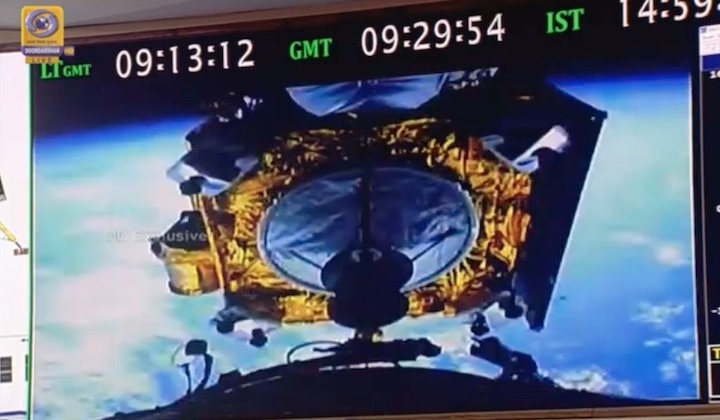
But Chandrayaan 2 has a long voyage before reaching the landing site.
“Now the mantle is given to the satellite team, our Chandrayaan 2 mission team,” Sivan said after Monday’s launch. “They are going to have to do 15 very crucial maneuvers during the next one-and-a-half months, and finally bring Chandrayaan 2 around the moon.
“After that, the D-Day will come, and on that day we are going to experience 15 minutes of terror to ensure the landing is safe near the south pole,” Sivan continued in remarks to VIPs and top government officials. “My dear friends, our task is not over.”
Five throttleable liquid-fueled engines will control the lander’s rate of descent, and a laser rangefinder will guide the spacecraft toward the landing zone.
Chandrayaan 2’s stationary lander and rover are designed to last 14 days — equivalent to half of a lunar day — until the sun sets at the landing site, robbing the vehicles of electrical power as temperatures plummet to near minus 300 degrees Fahrenheit (minus 183 degrees Celsius).
If the landing is successful, India will become the fourth nation to accomplish a controlled soft touchdown on the moon, following landings by the Soviet Union, the United States and China.
Clive Neal, a lunar scientist at the University of Notre Dame, said India’s space program is “making great strides” after placing spacecraft into orbit around the moon and Mars in 2008 and 2013, respectively.
Chandrayaan 2 is a follow-up to India’s Chandrayaan 1 lunar orbiter, which made history by detecting water-bearing molecules at the moon’s poles, with the highest concentrations inside permanently-shadowed craters at the south pole.
“This proof of capability, the Chandryaaan 2 mission with the lander and the rover, is very ambitious,” Neal said in an interview with Spaceflight Now.
And Chandrayaan 2’s cost of approximately $142 million is a fraction of the development budget for NASA’s Lunar Reconnaissance Orbiter, which cost more than $500 million to build and launch in 2009.
“They’ve got a nice landing site picked out,” Neal said before Chandrayaan 2’s launch. “It looks pretty benign in terms of small craters and boulders. This would be a pathfinder for future landings in more challenging environments, and because it’s a new place (to explore) on the moon, there will be good science that comes out of it.”
China is the most recent country to join the elite group of nations with successful moon landing missions. China’s Chang’e 3 mission landed on the near side of the moon in 2013, and Chang’e 4 made the first soft landing on the far side of the moon in January.
Chang’e 4’s lander and rover are still operating, and if successful, the arrival of Chandrayaan 2 in September could mark the first time since the 1970s that two spacecraft have operated on the moon’s surface at the same time.
“This is very exciting, and I wish them well,” Neal said. “They’ve got a wealth of experiments that they’re carrying on the orbiter, the lander and the rover. It’s going to tell us some interesting things about the lunar surface at a location we haven’t been to.”
ISRO says the orbiter’s mission will last at least a year, taking high-resolution images and scanning the lunar surface with radar and spectral imagers to hunt for signs of water ice.
Officials originally designed the Chandrayaan 2 mission as a joint endeavor with Russia, which was to provide the landing module to fly to the moon with an Indian-made orbiter and rover. But Russia dropped out of the project after the failure of the Phobos-Grunt Mars probe in 2011, prompting the Indian government to make Chandrayaan 2 an all-Indian mission.
“This mission is not only ISRO’s mission,” Sivan said in a press briefing last month. “It is a mission of the entire country.”
The Chandrayaan 2 spacecraft’s three components each carry a suite of scientific instruments:
- Orbiter
- Mass: 5,244 pounds (2,379 kilograms)
- Dimensions: 3.2 x 5.8 x 2.1 meters (10.5 x 19.0 x 6.9 feet)
- Power: 1,000 watts
- Description: The Chandrayaan 2 orbiter — designed for a one-year mission — carries eight scientific instruments, including a high-resolution stereo imaging camera, a dual-frequency synthetic aperture radar look for evidence of water ice at the lunar poles, an imaging infrared spectrometer to aid in the search for water, and sensors to study the moon’s tenuous atmosphere. The orbiter will also provide data relay services the Vikram lander.
- Vikram Lander
- Mass: 3,243 pounds (1,471 kilograms)
- Dimensions: 2.54 x 2.0 x 1.2 meters (8.33 x 6.6 x 3.9 feet)
- Power: 650 watts
- Description: The Vikram lander’s targeted touchdown zone is located in a highland region on the the near side of the moon at approximately 70.9 degrees south latitude, closer to the moon’s south pole than any previous lunar landing mission. Vikram will use five throttleable liquid-fueled engines to slow down for landing. The stationary landing craft carries a suite of multiple cameras and three science instruments, including a seismometer to listen for moonquakes, a thermal probe to reach a depth of up to 33 feet (10 meters) to measure the vertical temperature gradient in the lunar crust, sensors to investigate plasma near the moon’s surface, and a NASA-provided laser retroreflector array to help scientists locate the lander’s exact position on the moon. The Vikram lander is designed to last 14 days on the moon, equivalent to one lunar day.
- Pragyan Rover
- Mass: 59 pounds (27 kilograms)
- Dimensions: 0.9 x 0.75 x 0.85 meters (3.0 x 2.46 x 2.79 feet)
- Power: 50 watts
- Description: The solar-powered Pragyan rover has a range of up to 500 meters, or 1,640 feet, during its 14-day mission on the moon. The AI-enabled rover has six wheels and will relay science data and images through a radio link with the Vikram lander. Indian scientists installed an alpha particle X-ray spectrometer to measure the elemental composition of the rocks at the Chandrayaan 2 landing site, along with a laser-induced breakdown spectroscope. The Pragyan rover is named for the Sanskrit word for “wisdom.”
The lander’s targeted destination is roughly 220 miles (350 kilometers) from the rim of the South Pole-Aitken basin, a region scientists believe is one of the most ancient impact sites in the solar system, created when a large asteroid or comet struck the moon billions of years ago.
For the first time, Chandrayaan 2’s rover could examine ancient material in the lunar crust ejected during the colossal collision that created the South Pole-Aitken basin, providing data that could yield clues about the solar system’s chaotic early history.
China’s Chang’e 4 mission, landed on the far side of the moon in January, is exploring the mid-latitudes of the southern hemisphere, within the South Pole-Aitken basin.
Unlike the Indian Pragyan rover, Chang’e 4 does not carry an alpha X-ray spectrometer, or APXS, to obtain compositional measurements of the lunar crust. The presence of such an instrument on-board Chandrayaan 2 could be boon for lunar geologists.
Neal said he wished Chang’e 4’s rover, named Yutu 2, carried an APXS instrument to the far side of the moon.
The APXS on the Indian rover “will give us an idea of the chemical composition of the rocks that are there,” Neal said. “That is going to be a critical piece of the puzzle … It’s going to tell us more about the composition at that particular vicinity, whether or not it will find water. It doesn’t look like it’s too close to the permanently-shadowed regions, but we don’t know what’s underneath the regolith there.”
Science instrumentation on Chandrayaan 2’s orbiter could provide the most detailed data yet obtained about the amount of water ice hidden inside the moon’s polar craters. The sensors can also detect the presence of hydroxyl molecules, which have oxygen and hydrogen atoms bonded together.
The Indian orbiter’s dual-frequency radar, with L-band and S-band beams, will be sensitive to underground ice deposits up to 16 feet (5 meters) below the lunar surface, twice as deep as reachable by radars carried Chandrayaan 1 and NASA’s Lunar Reconnaissance Orbiter.
“I think on the orbiter — it’s got a year long mission — the radar would be good because although LRO has a radar, it is only in receiving mode, not transmission mode, so we have to transmit from Earth in order to use it right now,” Neal said. “So a lot of locations are not amenable to that.”
Chandrayaan 2 could give scientists more refined maps of the location of water ice deposits, and a more accurate inventory for how much water is trapped inside the permanently-shadowed polar craters.
“That has a lot of potential, as does the infrared spectrometer,” Neal said. “It’ll help show whether or not there’s a hydroxyl or water signal at the surface.”
Such information is critical for future human expeditions to the moon, such as those planned as part of NASA’s Artemis program, which aims to return astronauts to the moon by 2024 under a directive from the Trump administration.
India’s lunar lander may soon be joined on the moon by privately-developed probes and rovers. NASA awarded contracts to three U.S. companies to build robotic landers to carry U.S. science instruments to the moon in 2020 and 2021.
Earlier this year, a privately-funded Israeli spacecraft named Beresheet attempted to land on the moon, but the probe crashed during final descent.
Chandrayaan 2’s launch came two days after the 50th anniversary of the Apollo 11 moon landing.
“I think the international and the commercial interest in the moon is really fantastic, and what it shows us is that the world and private industry have caught up with NASA,” Neal said.
Quelle: SN
----
Update: 27.07.2019
.
Chandrayaan-2 successfully completes second orbit raising manoeuvre, says ISRO
An orbital manoeuvre or a 'burn' refers to an internal thrust system that helps a spacecraft change orbit.
Bengaluru: The second earth-bound orbit raising manoeuvre for Chandrayaan-2 spacecraft was performed in the early hours of Friday, the Indian Space Research Organisation (ISRO) said.
The manoeuvre was carried out at 1.08 am using the on-board propulsion system for a firing duration of 883 seconds, the space agency said in a statement.
With this effort, the spacecraft was pushed to an orbit of 251 X 54,829 km, it said.
ISRO announced that all the parameters of the spacecraft were normal.
The third orbit raising manoeuvre will be performed on July 29 afternoon.
The ambitious project of sending a spacecraft with a moonlander and a rover was launched on July 22 afternoon.
The ISRO is aiming for a soft landing of the lander (spacecraft) in the South Pole region of the moon where no country has gone so far.
The earth-bound manoeuvres had started from Wednesday and it will culminate into Trans Lunar Insertion, scheduled on August 14, 2019, which will send the Chandrayaan-2 spacecraft to the moon.
If successful, it will make India the fourth country after Russia, the US and China to pull off a soft landing on the moon.
Quelle: The Print
+++
Chandrayaan-2 Successfully Performs Second Orbit Raising Manoeuvre: ISRO
Chandrayaan-2's third orbit raising manoeuvre is scheduled on July 29, 2019, between 2:30 - 3:30pm IST.
India's second moon spacecraft Chandrayaan-2 put into earth orbit on July 22, on Friday successfully completed its second earthbound orbit-raising manoeuvre, ISRO said.
It was "performed successfully today (July 26, 2019) at 0108 hrs (IST) as planned, using the onboard propulsion system for a firing duration of 883 seconds. The orbit achieved is 251 x 54829 km. All spacecraft parameters are normal," the Indian Space Research Organisation tweeted.
"The third orbit raising manoeuvre is scheduled on July 29, 2019, between 1430-1530 hrs (IST)," it added.
The first one was performed on July 24.
The Chandrayaan-2 is scheduled to reach moon by August 20, the Indian space agency had said on Wednesday.
According to Indian Space Research Organisation (ISRO), the first earth bound orbit raising manoeuvre for Chandryaan-2 spacecraft was successfully performed on Wednesday afternoon by firing the onboard motors for 57 seconds.
On July 22, the Chandrayaan-2 was injected into an elliptical orbit of 170x45,475 km by India's heavylift rocket Geosynchronous Satellite Launch Vehicle-Mark III (GSLV Mk III) in a text book style.
The spacecraft Chandrayaan-2 comprises three segments - the Orbiter (weighing 2,379 kg, eight payloads), the lander 'Vikram' (1,471 kg, four payloads) and rover 'Pragyan' (27 kg, two payloads).
The Indian space agency said the major activities include earth bound manoeuvres, Trans Lunar Insertion, Lunar bound manoeuvres, the lander Vikram separation from Chandrayaan-2 and Vikram touch down on the moon's South Pole.
The ISRO said the Trans Lunar Insertion of Chandrayaan-2 is scheduled on August 14, 2019, which will send the spacecraft to moon.
After that, the Chandrayaan-2 is scheduled to reach moon by August 20, 2019, the ISRO said.
According to ISRO, the lander Vikram will land on the moon on September 7.
Originally the GSLV-Mk III rocket carrying Chandrayaan-2 was supposed to fly on July 15. Owing to a serious technical glitch the flight was postponed to July 22.
As a result, there are changes in the mission schedule.
As per the July 15 flight schedule, Chandrayaan-2's earth bound phase was 17 days and it is 23 days as per the new schedule.
On the other hand, the lunar bound phase which was for 28 days for July 15 flight schedule, has come down to 13 days.
Originally Vikram was planned to land on the moon 54 days after the rocket's lift off and now the landing will take place in 48 days.
Quelle: Gadgets360
----
Update: 31.07.2019
.
CHANDRAYAAN 2: THIRD ORBIT-RAISING OF SPACECRAFT COMPLETED SUCCESSFULLY, ISRO CONFIRMS
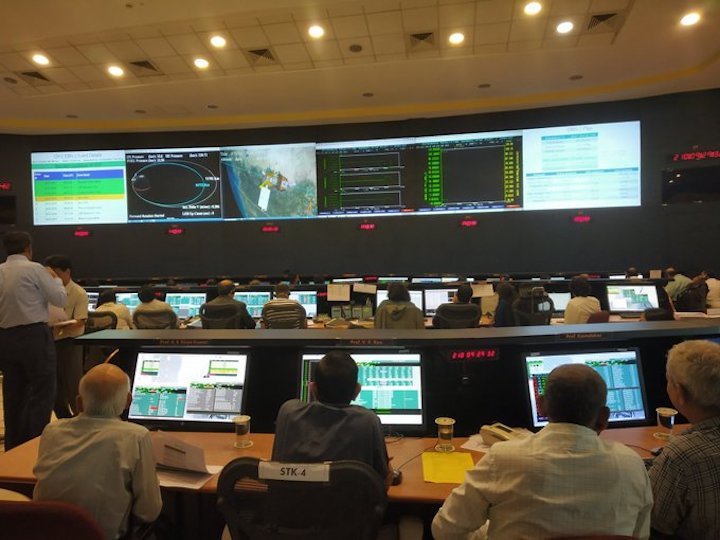
The third of five earth-bound orbit-raising manoeuvres of the Chandrayaan 2 spacecraft has been successfully completed Monday afternoon, as planned, the Indian Space Research Organisation confirmed in a tweet.
The manoeuvre was carried out at 3.12 pm IST using the onboard propulsion system for a firing duration of 989 seconds (~16 minutes), two days after the second orbit-raising was completed, placing the spacecraft in a 251 x 54,829 km orbit (nearest x furthest Earth-bound altitude), according to ISRO. The final orbit achieved by the Chandrayaan 2 spacecraft after the second orbit-raising is 276 X 71,792 km.
ISRO also reported that all the spacecraft parameters were normal, and that the fourth orbit-raising is scheduled for the early afternoon on 2 August at 2 - 3 pm IST.
On 22 July, India launched the country's second moon mission, Chandrayaan 2, aboard the most powerful rocket in ISRO's arsenal, the GSLV-MkIII-M1, from the spaceport of Sriharikota in Andhra Pradesh. The mission was primarily aimed at landing a rover in the unexplored lunar south pole. The 3,850-kg, Rs 978-crore spacecraft is a three-module composite made up of an orbiter, lander, and rover. On its planned 48-day journey between liftoff and landing on the Moon's South Pole, the composite will be subjected to a series of orbital manoeuvres to bring it to the moon's vicinity.
"Further major activities include Earth-bound manoeuvres, Trans Lunar Insertion, Lunar bound manoeuvres, Vikram Separation and Vikram Touch Down," the space agency said.
As per ISRO's schedule, the Vikram lander will attempt a soft-landing on the moon on 7 September, and open its hatch for the Pragyan rover to take its first few rolls onto lunar soil four hours later. The landing site of the mission is closer to the South Pole than any mission before it.
ISRO said that the earth-bound manoeuvres are planned from 24 July onwards, culminating in the fifth and final orbit-raising on 14 August 2019, setting Chandrayaan 2 on its way to the moon. ISRO has called the mission its most complex and prestigious mission ever. If successful, Chandrayaan 2 will propel India to an elite list of four nations (including Russia, the US and China) that have pulled off a soft-landing on the moon.
Quelle: TECH2
----
Update: 3.08.2019
.
Chandrayaan-2 Orbit Successfully Raised for Fourth Time: ISRO
Chandrayaan-2's fifth orbit-raising manoeuvre is scheduled between 2:30pm to 3:30pm. on August 6.
The fourth orbit raising activity for India's moon spacecraft Chandrayaan-2 was performed successfully at 3:27pm on Friday, the ISRO said. The Indian Space Research Organisation (ISRO) said the orbit of the Chandrayaan-2 was raised to 277 x 89,472 km by firing the onboard motors for 646 seconds. All spacecraft parameters are normal, it said. The fifth orbit-raising manoeuvre is scheduled between 2:30 to 3:30pm on August 6. The third orbit raising activity was completed on July 29.
On July 22, the Chandrayaan-2 was injected into an elliptical orbit of 170x45,475 km by India's heavy-lift rocket Geosynchronous Satellite Launch Vehicle-Mark III (GSLV Mk III) in a textbook style.
The spacecraft comprises three segments - the Orbiter (weighing 2,379 kg, eight payloads), the lander 'Vikram' (1,471 kg, four payloads) and rover 'Pragyan' (27 kg, two payloads).
The Indian space agency said the major activities include earth-bound manoeuvres, the trans-lunar insertion, lunar-bound manoeuvres, Vikram's separation from Chandrayaan-2 and touch down on the moon's South Pole.
The ISRO said the trans-lunar insertion of Chandrayaan-2, which will send it to the moon, is scheduled on August 14.
After that, the Chandrayaan-2 is scheduled to reach the moon by August 20 and the lander Vikram will land on the Earth's sole satellite on September 7.
Quelle: Gadgets360
----
Update: 4.08.2019
.
ISRO releases Chandrayaan-2’s first set of pictures of Earth
The Lander ‘Vikram’ and the rover ‘Pragyaan’ is set to make the lunar landing on September 7.
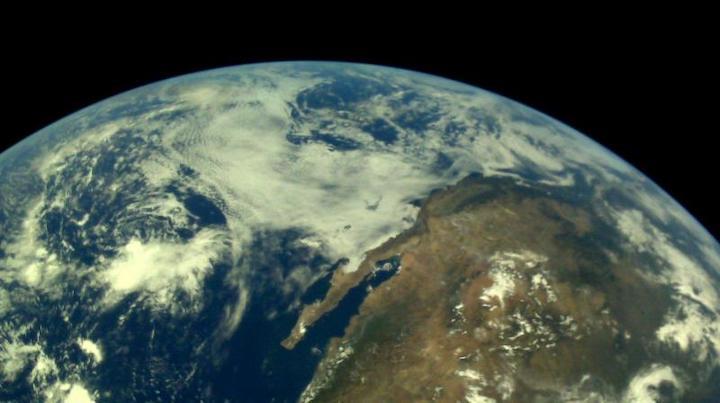
The Pacific ocean and the continent of America are visible in the pictures which were taken from a distance of 5,000km. (Photo: ISRO/Twitter)
Five images were released by the Indian Space Research Organisation (ISRO) on their twitter handle.The images were taken from the L14 camera aboard Chandrayaan-2. The Pacific ocean and the continent of America are visible in the pictures which were taken from a distance of 5,000km.
“I am extremely happy with the mission so far. The images taken by the lander suggest it should be able to function as expected during the 15-terrifying moments when it goes in for the lunar landing,” said ISRO chairman K Sivan.
The Lander ‘Vikram’ and the rover ‘Pragyaan’ is set to make the lunar landing on September 7.
The third orbit raising manuevre was completed on July 29 and the the fourth on August 2.
Chandrayaan-2 made its way into the orbit on July 22 aboard the GSLV Mark III-M1, which had taken off from the Satish Dhawan space centre in Andhra Pradesh’s Sriharikota.
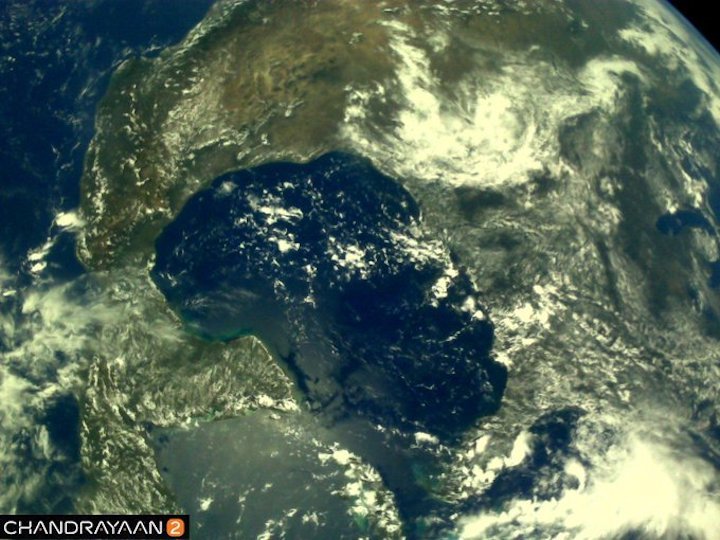
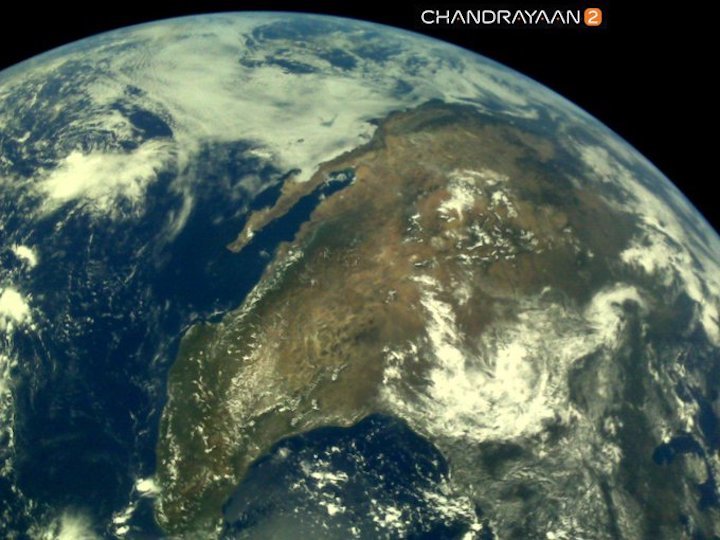
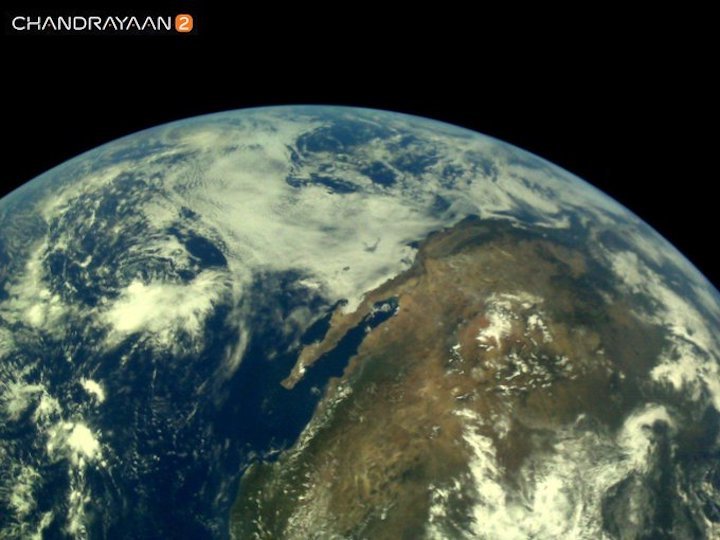
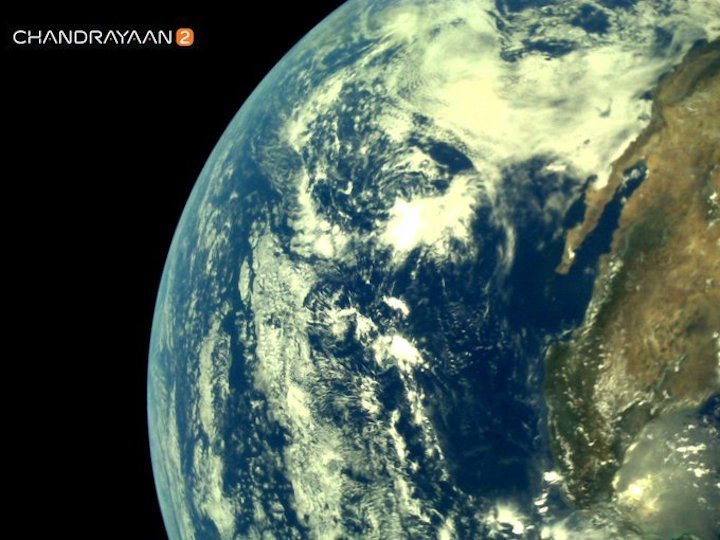
Quelle: Deccan Chronicle
----
Update: 8.08.2019
.
ISRO Chandrayaan-2 Successfully Completes 5th Orbital Manoeuvre
The orbit of Chandrayaan-2 was raised to an orbit of 276x142,975km.
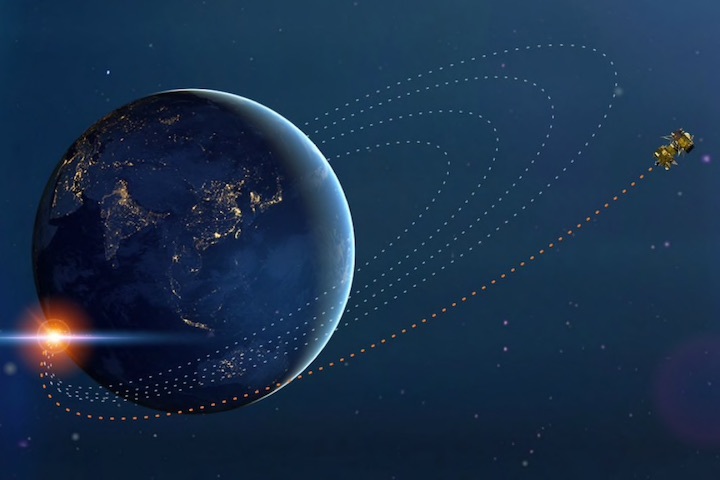
The Indian space agency on Tuesday successfully raised Chandrayaan-2's orbit for fifth time at 3:04pm.
According to Indian Space Research Organisation (ISRO), the orbit of Chandrayaan-2 was raised to an orbit of 276x142,975km by firing the spacecraft's onboard motors for 1,041 seconds.
All spacecraft parameters were normal.
The next manoeuvre is Trans Lunar Insertion (TLI), which is scheduled for August 14, 2019, between 3-4am.
On July 22, the Chandrayaan-2 was injected into an elliptical orbit of 170x45,475km by India's heavy lift rocket Geosynchronous Satellite Launch Vehicle-Mark III (GSLV Mk III) in a textbook style.
The spacecraft comprises three segments - the Orbiter (weighing 2,379kg, eight payloads), the lander 'Vikram' (1,471kg, four payloads) and rover 'Pragyan' (27kg, two payloads).
The Indian space agency said the major activities include Earth-bound manoeuvres, the trans-lunar insertion, lunar-bound manoeuvres, Vikram's separation from Chandrayaan-2 and touch down on the Moon's South Pole.
The ISRO said the trans-lunar insertion of Chandrayaan-2, which will send it to the moon, is scheduled on August 14.
After that, the Chandrayaan-2 is scheduled to reach the Moon by August 20 and the lander Vikram will land on the Earth's sole satellite on September 7.
Quelle: Gadgets360
----
Update: 14.08.2019
.
Isro: Chandrayaan-2 will move towards moon early tomorrow
The Chandrayaan-2 composite body, including the orbiter, lander, and rover,is now revolving around the Earth. At around 3.30 am on August 14, we are going to have a manoeuvre called trans-lunar injection. By this manoeuvre, the Chandrayaan-2 will leave the Earth and move towards the moon.
In a crucial move on Wednesday early morning,Indian Space Research Organisation (ISRO) scientists will send the Chandrayaan-2 hurtling towards the moon. The spacecraft, which is currently revolving in a highly elliptical orbit around the Earth, will be injected in a trans-lunar path to cover most of the 384,400-km distance between the Earth and the moon.
The manoeuvre will raise the orbit to approximately 266x413,623 km and will happen between 3am and 4am when Chandrayaan-2 nears the highest point in the elliptical orbit around Earth.
“After launching Chandrayaan-2 on July 22, we did five manoeuvres. The Chandrayaan-2 composite body, including the orbiter, lander, and rover,is now revolving around the Earth. At around 3.30 am on August 14, we are going to have a manoeuvre called trans-lunar injection. By this manoeuvre, the Chandrayaan-2 will leave the Earth and move towards the moon,” said ISRO chairperson Dr K Sivan.
The spacecraft will stay in this path for seven days before being inserted into an orbit around the moon on August 20.
Just like around the Earth, the scientists will have to carry out ‘burns’ or firing of the on-board propulsion engines four times to get the spacecraft into a circular 100x100-km orbit around the moon.
This is where the orbiter will circle around for its mission life of one year. The lander-rover, on the other hand, will separate out and reduce the orbit to 100x30 km before attempting a soft landing on the South Pole of the moon on September 7 at 02.58 am.
This powered decent to the surface of the moon has been described as the “most terrifying 15 minutes”. On its journey towards the lunar surface, the lander-rover have to autonomously decide a landing site between craters Manzinus C and Simpelius N. The landing site has to be close enough to study the shadowy region within the craters, yet at a high point within the reach of the sunrays.
The landing will be aided by images from the on-board high resolution camera, which will be transmitted to Earth, processed and a landing site map uploaded to the lander-rover before the powered descent.
The lander-rover will conduct experiments for a lunar day, equivalent to 14 Earth days. If successful, Chandrayaan-2 will become the only mission in the world to land on the South Pole of the moon.
Quelle: Hindustan Times
+++
Chandrayaan-2 to reach moon's orbit on 20 August: Isro
- 'Chandrayaan-2' is expected to land on the lunar surface on 7 September, Isro chairman Dr K. Sivan said
- The Isro chairman said Chandrayaan-2 is all set to leave the earth's orbit after two days
Ahmedabad: India's second moon mission 'Chandrayaan-2' is expected to reach the moon's orbit on 20 August and land on the lunar surface on 7 September, Indian Space Research Organisation (Isro) chairman Dr K. Sivan said on Monday.
The spacecraft is all set to leave the earth's orbit after two days, he told reporters here.
Sivan was on the city to take part in the birth centenary celebrations of Dr Vikram Sarabhai, regarded as the father of India's space programme.
The 3,850-kg Chandrayaan-2, a three-module spacecraft comprising orbiter, lander and rover, which was launched on 22 July, would make a landing on the moon on 7 September, the Isro chief said.
"After launching Chandrayaan-2 on 22 July, we did five maneuvers. The Chandrayaan-2 composite body is now revolving around the earth," he said.
The next very important and crucial maneuver will happen on Wednesday morning.
"At around 3.30 am on 14 August, we are going to have a maneuver called trans-lunar injection. By this maneuver, the Chandrayaan-2 will leave the earth and move towards the moon. On 20 August, we will be reaching the moon," he said.
"Then, we will be carrying out lunar orbit insertion. By this process, the Chandrayaan-2 will be around the moon on 20 August. Subsequently, we have planned to have a series of maneuvers around the moon and finally on September 7, we will be landing on the moon near its south pole," he added.
Sivan said the spacecraft was "doing very well" at present and all its systems were functioning properly.
He said scientists at the ISRO will be busy in coming months, particularly in December when the space agency would take up a mission to launch small satellites.
"In December, we are going to have a very important mission. It's a small satellite launcher. This is for the first time we are going to have this mission," he said.
Quelle: livemint
+++
Update:
Chandrayaan-2 Successfully enters Lunar Transfer Trajectory
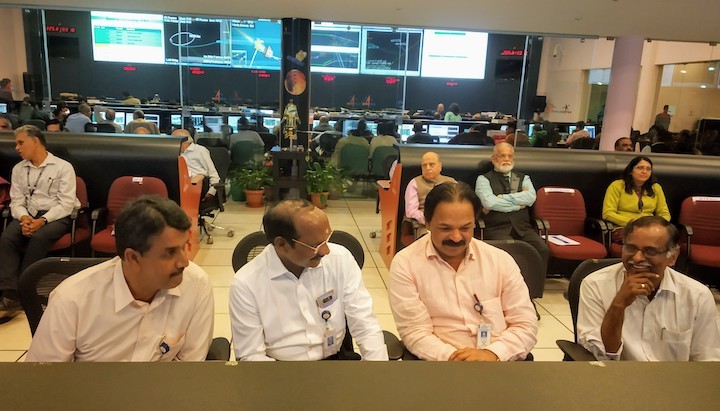
The final orbit raising manoeuvre of Chandrayaan-2 spacecraft was successfully carried out today (August 14, 2019) at 02:21 am IST. During this maneuver, the spacecraft's liquid engine was fired for about 1203 seconds. With this, Chandrayaan-2 entered the Lunar Transfer Trajectory. Earlier, the spacecraft’s orbit was progressively increased five times during July 23 to August 06, 2019.
The health of the spacecraft is being continuously monitored from the Mission Operations Complex (MOX) at ISRO Telemetry, Tracking and Command Network (ISTRAC) in Bengaluru with support from Indian Deep Space Network (IDSN) antennas at Byalalu, near Bengaluru. Since its launch on July 22, 2019 by GSLV MkIII-M1 vehicle, all systems onboard Chandrayaan-2 spacecraft are performing normal.
Chandrayaan-2 will approach Moon on August 20, 2019 and the spacecraft's liquid engine will be fired again to insert the spacecraft into a lunar orbit. Following this, there will be further four orbit maneuvers to make the spacecraft enter into its final orbit passing over the lunar poles at a distance of about 100 km from the Moon’s surface.
Tentative plan for future operation after Trans Lunar Injection are as follows,
|
|
Date |
Time |
Orbit around moon |
|
LOI/LBN#1 |
August 20, 2019 |
8:30-9:30 |
118 X 18078 |
|
LBN#2 |
August 21, 2019 |
12:30 – 13:30 |
121 X 4303 |
|
LBN#3 |
August 28, 2019 |
05:30 – 06:30 |
178 X 1411 |
|
LBN#4 |
August 30, 2019 |
18:00 – 19:00 |
126 X 164 |
|
LBN#5 |
September 01, 2019 |
18:00 – 19:00 |
114 X 128 |
Subsequently, Vikram lander will separate from the orbiter on September 02, 2019. Two orbit maneuvers will be performed on the lander before the initiation of powered descent to make a soft landing on the lunar surface on September 07, 2019.
Quelle: ISRO
+++
What are the scientific objectives of Chandrayaan 2? Why explore the Lunar South Pole?
Moon provides the best linkage to Earth’s early history. It offers an undisturbed historical record of the inner Solar system environment. Though there are a few mature models, the origin of Moon still needs further explanations. Extensive mapping of lunar surface to study variations in lunar surface composition is essential to trace back the origin and evolution of the Moon. Evidence for water molecules discovered by Chandrayaan-1, requires further studies on the extent of water molecule distribution on the surface, below the surface and in the tenuous lunar exosphere to address the origin of water on Moon.
The lunar South Pole is especially interesting because of the lunar surface area here that remains in shadow is much larger than that at the North Pole. There is a possibility of the presence of water in permanently shadowed areas around it. In addition, South Pole region has craters that are cold traps and contain a fossil record of the early Solar System.
Chandrayaan-2 will attempt to soft land the lander -Vikram and rover- Pragyan in a high plain between two craters, Manzinus C and Simpelius N, at a latitude of about 70° south.
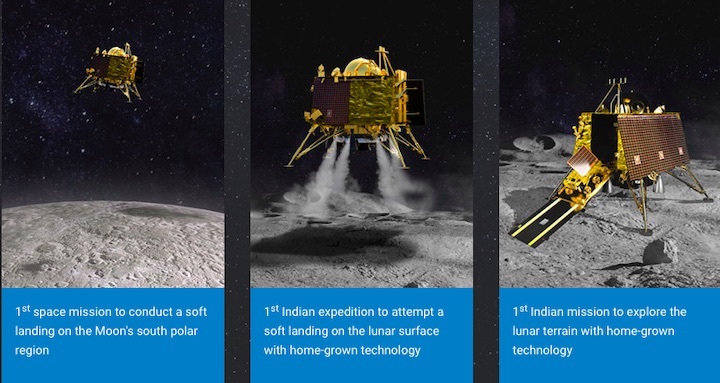
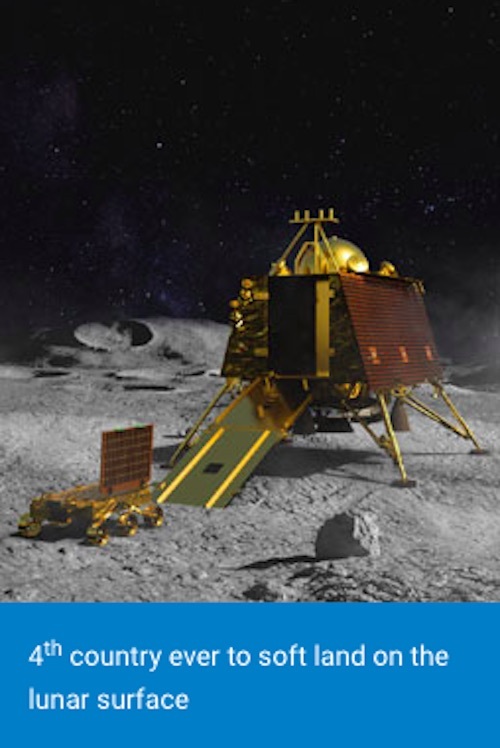
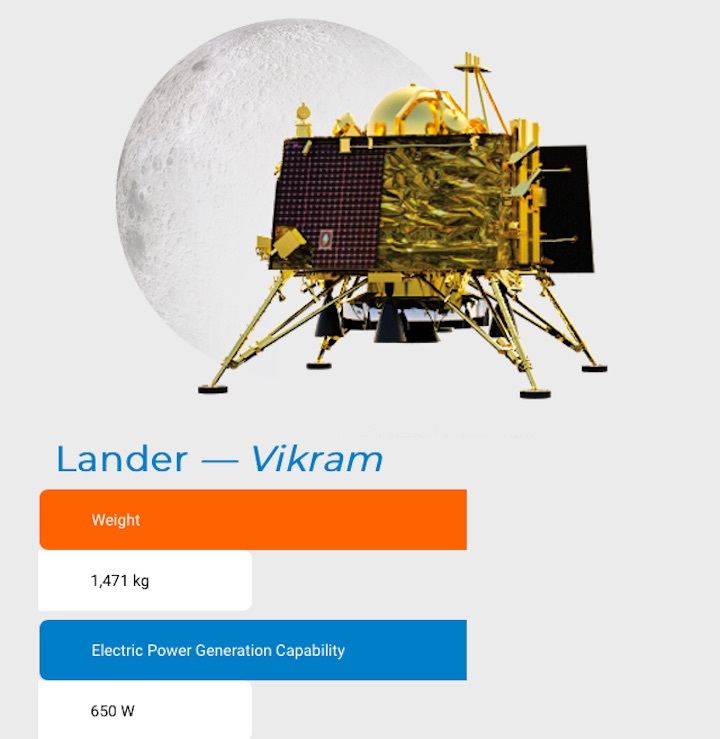
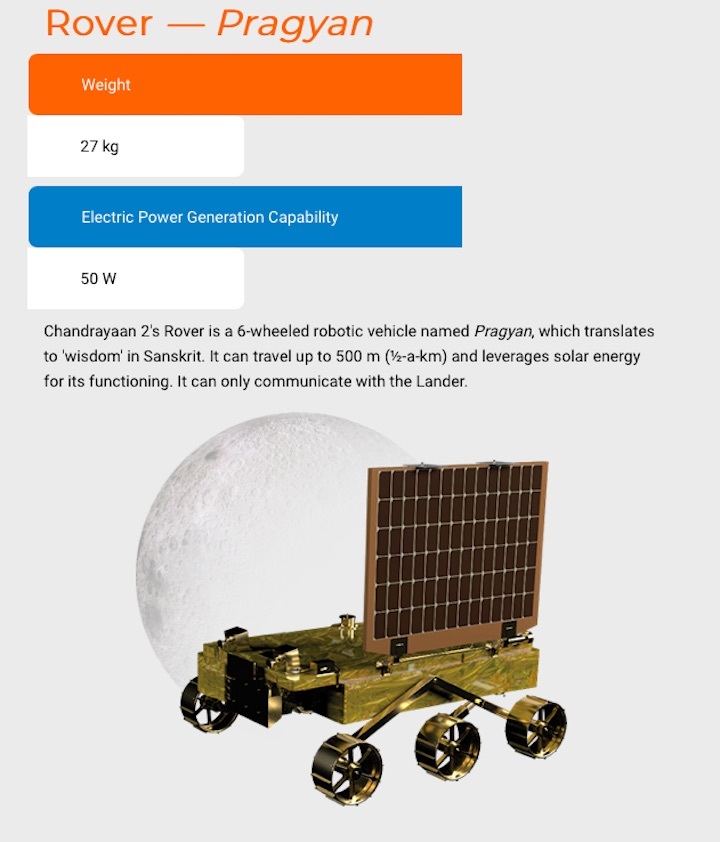
Quelle: ISRO
----
Update: 19.08.2019
.
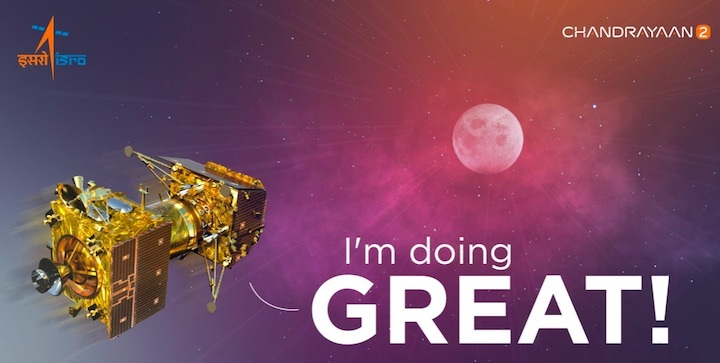
Hello! This is Chandrayaan 2 with a special update. I wanted to let everyone back home know that it has been an amazing journey for me so far and I am on course to land on the lunar south polar region on 7th September. To know where I am and what I'm doing, stay tuned!
Quelle: ISRO
+++
ISRO to inject Chandrayaan 2 into lunar orbit tomorrow
- The Vikram lander will separate from the orbiter on September 2
- There will be further four orbit manoeuvres to make the spacecraft enter into its final orbit
Bengaluru: In a significant milestone for India's Moon mission, ISRO will fire Chandrayaan 2's liquid engine on Tuesday to insert the spacecraft into a lunar orbit.
"It's tomorrow morning (tentatively between 8.30 am and 9.30 am). It's challenging," Chairman of Indian Space Research Organisation K Sivan said on Monday on the operation to put the spacecraft in an orbit around the Moon.
Following this, there will be further four orbit manoeuvres to make the spacecraft enter into its final orbit passing over the lunar poles at a distance of about 100 km from Moon's surface, ISRO has said.
Subsequently, the Vikram lander will separate from the orbiter on September 2, according to the Bengaluru-headquartered space agency.
Two orbit manoeuvres will be performed on the lander before the initiation of powered descent to make a soft landing on the lunar surface on September 7, ISRO said.
Chandrayaan 2, launched on July 22 by GSLV MkIII-M1 vehicle, had entered the Lunar Transfer Trajectory on August 14 after final orbit raising manoeuvre of the spacecraft was successfully carried out.
The health of the spacecraft is being continuously monitored from the Mission Operations Complex (MOX) at ISRO Telemetry, Tracking and Command Network (ISTRAC) in Bengaluru with support from Indian Deep Space Network (IDSN) antennas at Byalalu, near Bengaluru.
All systems on board Chandrayaan 2 spacecraft are performing normal, ISRO said on August 14.
According to ISRO, Chandrayaan 2 — India's second lunar expedition — will shed light on a completely unexplored region of the Moon, its South Pole.
"This mission will help us gain a better understanding of the origin and evolution of the Moon by conducting detailed topographical studies, comprehensive mineralogical analyses, and a host of other experiments on the lunar surface," the space agency has said.
"While there, we will also explore discoveries made by Chandrayaan 1, such as the presence of water molecules on the Moon and new rock types with unique chemical composition," it said.
Quelle: livemint
----
Update: 20.08.2019
.
Chandrayaan-2 update: Lunar Orbit Insertion
Lunar Orbit Insertion (LOI) maneuver was completed successfully today (August 20, 2019). The duration of maneuver was 1738 seconds beginning from 0902 hrs IST. With this, Chandrayaan-2 was successfully inserted into a Lunar orbit. The orbit achieved is 114 km x 18072 km.
Following this, a series of orbit maneuvers will be performed on Chandrayaan-2 spacecraft to enable it to enter its final orbit passing over the lunar poles at a distance of about 100 km from the Moon’s surface.
Subsequently, the lander will separate from the Orbiter and enters into a 100 km X 30 km orbit around the Moon. Then, it will perform a series of complex braking maneuvers to soft land in the South polar region of the Moon on September 7, 2019.
The health of the spacecraft is being continuously monitored from the Mission Operations Complex (MOX) at ISRO Telemetry, Tracking and Command Network (ISTRAC) in Bengaluru with support from Indian Deep Space Network (IDSN) antennas at Bylalu, near Bengaluru. All the systems of Chandrayaan-2 are healthy.
The next Lunar bound orbit maneuver is scheduled tomorrow (August 21, 2019) between 1230-13:30 hrs IST.
Spacewatch: India’s moon mission arrives in lunar orbit
If Chandrayaan-2 is successful, it will make India the fourth country to reach the moon’s surface
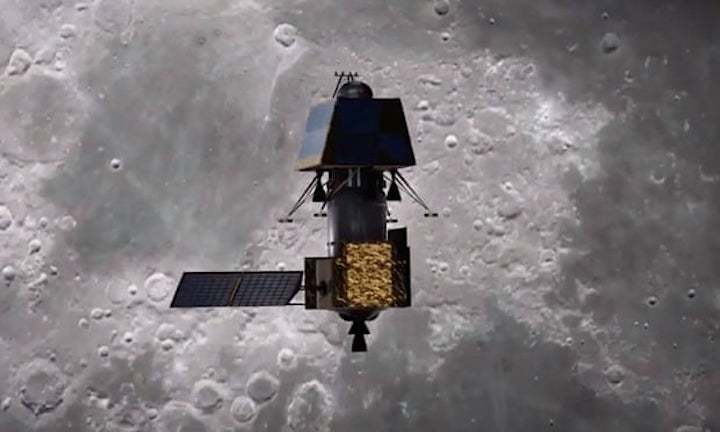
India’s moon mission, Chandrayaan-2, has arrived in lunar orbit. The spacecraft is engaged in a series of manoeuvres that will place it in its final operating orbit, a circular path looping over the moon’s poles at an altitude of 100km (62 miles).
Chandrayaan-2 entered lunar orbit at about 0500 BST on 20 August. Its initial orbit was highly elliptical, swinging from 114km above the moon to 18,072km. A second rocket burn on 21 August changed this to 118km and 4,412km.
The next orbital manoeuvre is planned for 28 August. Once the mission arrives in its final orbit, ground controllers will deploy the Vikram lander. This will begin its own sequence of braking manoeuvres to bring it to a touchdown at the lunar south pole on 7 September.
If successful, it will make India the fourth country to reach the moon’s surface, behind Russia, the US and China.
The spacecraft was developed and launched by the Indian Space Research Organisation, which reports that the vehicle’s systems are healthy. The mission lifted off on 22 July from the Satish Dhawan space centre, in Sriharikota, an island off the coast of Andhra Pradesh.
Quelle: The Guardian

